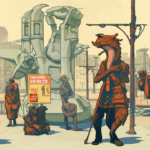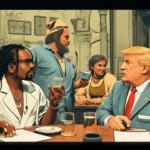Why It’s Important to Teach Kids About Political Parties
How to Explain Democrat vs Republican to a Child: Teaching children about political parties is a great way to build their understanding of how the world works. Kids are naturally curious, and explaining the basics of Democrats and Republicans can help them learn about leadership, decision-making, and fairness.
By introducing these concepts, kids can begin to see how the government influences everyday life, like schools, parks, or even the roads we drive on. How to Explain Democrat vs Republican to a Child- It also encourages critical thinking—helping children learn how to understand differences and make informed decisions as they grow older.
What Are Democrats and Republicans?

The United States has two major political parties: How to Explain Democrat vs Republican to a Child. These are groups of people who work together to share their ideas about how the country should be run.
- Democrats believe that the government should help people by creating programs for schools, healthcare, and the environment.
- Republicans think it’s better for people and businesses to solve problems on their own without too much government involvement.
You can explain it like two teams playing a game, but instead of sports, they’re working on ideas to make life better for everyone.
Key Values of Democrats and Republicans
Democrat Values Explained for Kids
Democrats believe in working together to solve problems. They often talk about fairness, helping people who need extra support, and making rules to protect the environment. They want schools and hospitals to be available for everyone.
Republican Values Explained for Kids
Republicans believe in working hard and making decisions for yourself. They think the government shouldn’t make too many rules and that families and businesses should have the freedom to grow without too much help or control.
Differences Between Democrats and Republicans

Here’s a simple breakdown of how the two parties think differently:
- Role of Government: Democrats believe the government should play a bigger role in helping people. Republicans think the government should step back and let people solve their own problems.
- Taxes and Economy: Democrats think wealthier people should pay higher taxes to support public services. Republicans believe lower taxes help everyone grow and succeed.
- Social Issues: Democrats focus on making sure everyone is treated equally, while Republicans value traditions and family.
How to Simplify Politics for Kids
Explaining politics to kids doesn’t have to be complicated. Here are some tips:
- Use Analogies: Compare politics to something kids understand, like teamwork or sharing responsibilities at home.
- Focus on Respect: Teach kids that people can have different opinions and still work together.
Fun Ways to Teach Political Concepts
- Storytelling: Create a story about a town deciding how to build a new park. Some characters want to save money (Republicans), while others want to add swings and slides for everyone (Democrats).
- Role Play: Let kids pretend to be decision-makers, debating on how to solve a problem in their school or neighborhood.
- Games and Activities: Use board games or online activities that teach collaboration and problem-solving.
Explaining Elections to Children
Kids often hear about How to Explain Democrat vs Republican to a Child elections but may not fully understand how they work. Here’s how you can explain it:
- What is Voting? Voting is like choosing your favorite flavor of ice cream. Everyone gets one vote, and the flavor with the most votes wins.
- Why Do People Vote? Voting lets people pick leaders and decide what’s best for their community.
Teaching the Importance of Compromise
Democrats and Republicans don’t always agree, but they often have to work together to make laws. This is called compromise, where both sides give up a little to create something everyone can agree on.
Use examples like sharing toys or picking a family movie to explain the importance of compromise to kids.
Addressing Common Questions Kids Might Ask

- Why do people disagree on politics? Explain that everyone has different experiences and values, which shape their opinions.
- Can a person like ideas from both parties? Yes! Some people choose ideas from both Democrats and Republicans, depending on what they think is best.
Encouraging Kids to Form Their Own Opinions
Help kids understand that it’s okay to ask questions and learn more about both parties. Encourage them to think critically and respect different views.
Challenges of Explaining Politics to Children
Talking about politics can be tricky. You want to be honest but also avoid showing bias. Keep your explanations simple and age-appropriate, focusing on the values and ideas rather than political arguments.
Table Comparing Democrat and Republican Values
| Topic | Democrat View | Republican View |
|---|---|---|
| Role of Government | Government helps people | Limited government role |
| Taxes | Higher taxes for wealthy | Lower taxes for everyone |
| Environment | Protecting nature is essential | Economic growth is priority |
Conclusion: Helping Kids Understand Politics
Teaching children about How to Explain Democrat vs Republican to a Child is about more than just politics—it’s about helping them understand how people work together to solve problems. By focusing on respect, compromise, and critical thinking, kids can learn to appreciate different perspectives and make informed decisions in the future.
FAQs
- How do you explain the two main political parties to a child?
Use simple examples like teamwork, sharing responsibilities, and solving problems differently. - What is the simplest way to describe Democrats and Republicans?
Democrats believe in helping people through government programs, while Republicans focus on self-reliance and limited government. - Should kids learn about politics at a young age?
Yes, age-appropriate discussions help them understand the world and become informed citizens. - Can someone belong to both political parties?
People can have views that align with both parties without officially joining one. - How do I keep political discussions unbiased when talking to kids?
Focus on explaining ideas and values rather than opinions, and emphasize the importance of respect for all views.







